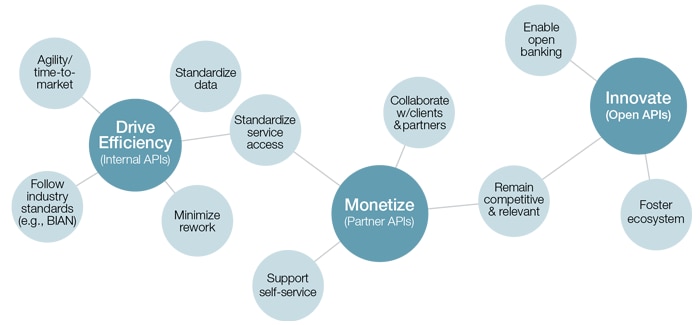How traditional banks can thrive in a digitally transformed industry
Spoiler alert: there will be no descriptions of motion-captured, super-intelligent chimps in this blog. There will be some discussion of seismic shifts in the world – just not done quite as dramatically as a big budget movie. But digital transformation is changing our world, disrupting the banking industry and other sectors in powerful ways. Traditional banks are worried that the rise of new, digitally enabled threats will become the dominant force in the industry. One key to surviving, and actually thriving in this new world, could be application programming interfaces (APIs).
While the API, which allows applications to connect, is not new to the banking industry, what is new is how it is being leveraged by banks today. By adopting open APIs, banks can enable third-party applications to integrate with their existing systems. (See my colleague Jerry Norton’s blog, Open APIs - a coming of age). This is one of the single, most effective innovation tools to drive creativity, new business models, speed to market and cost reduction. APIs also present a unique opportunity for banks to bring FinTech innovation into their own fold
Drivers and motivations for banks
Financial institutions worldwide are looking at open APIs to help build the future of banking. While the threat of fintechs, regulation (such as Europe’s revised Payment Services Directive, PSD2) and FOMO (fear of missing out) are perfectly valid reasons to adopt APIs, the real value is to position APIs as the binding force bringing the power of internal systems, coupled with partners and fintechs, to drive disruptive innovation in a collaborative ecosystem.
We see three primary motivations for banks to make APIs a key part of their transformational programs: 1) drive efficiency, 2) monetize and 3) innovate.
Lessons learned from the retail industry
The retail industry is a poster child for how adoption of APIs creates winners and losers. While the closure of a number of high-profile, big-box retailers may not be entirely due to their resistance to go digital, when history is written, non-adoption of APIs would be near the top of a long list of reasons for their demise.
A typical retail enterprise architecture is still highly fragmented (banks, you are not alone). However what makes successful digital retailers click is their ability to connect their fragmented infrastructure and bring it all together. And it’s all done using APIs.
Banks would be wise to take heed of the example of retail, looking at the following success factors:
- Make the API strategy an extension of the digital strategy.
- Use APIs to leverage the existing or planned digital ecosystem.
- Build on recent technology investments.
- Fail fast and move forward.
- Adopt a unified platform for APIs and service-oriented architecture.
- Don’t forget organization alignment along with an API approach.
- Think platform and reinforce the use of internal APIs all the time.
Why wait?
Traditionally banks have waited to see how the market and competition adopt a new technology before making significant investments. While this may have been a good strategy in a closed market with regulators always keeping the barrier to entry high, it is likely to prove very risky in today’s fast-changing landscape.
We see regulators across the globe wanting to increase market competition, and open APIs are their lever of choice. While regulations like PSD2 (requiring banks to make it easier to share customer data, where consent is given, with third-party providers) may not cross over the pond to the North American market, banking organizations such as NACHA are being proactive, self-adopting prudent initiatives from other geographies. Regardless, every year we’ll see more and more fintechs nibbling at banks’ business.
Open APIs provide a unique opportunity for banks to change the game. By adopting them, and I mean truly adopting (not check–the-box adopting), 2017’s competition could instead become co-opetition and be brought into the fold of banking services.






